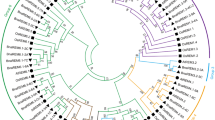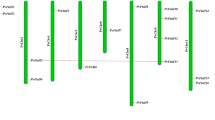Abstract
A novel dehydrin gene designated as Cbcor29 was cloned from Capsella bursa-pastoris by rapid amplification of cDNA ends (RACE) and genome walker technique. The full-length cDNA of Cbcor29 was 1101 bp long with a 783 bp open reading frame (ORF), encoding a putative protein of 261 amino acids. Like other dehydrin proteins, CbCOR29 contained a high percentage of charged and polar amino acids, in which Cys and Trp amino acids were absent. In addition, the predicted CbCOR29 protein possesses three conserved repeats of the characterized Lys-rich domains (K-segments), and a Ser-rich domain (S-segment) prior to the first Lys-rich domain, which presented a typical SK3 structure of dehydrins. Analysis of Cbcor29 genomic DNA revealed that it contains 2 exons and 1 intron, which is a typical character of dehydrin genes. Subsequent bioinformatic analysis also showed that the sequence of CbCOR29 has high homology with other dehydrin proteins, especially with cor47 from Arabidopsis thaliana. Moreover, semi-quantitative RT-PCR revealed that the expression of Cbcor29 can be induced by exposure to drought, low temperature, NaCl, and exogenous ABA treatment. Our study led to the conclusion that the Cbcor29 gene is a new member of the dehydrin gene family and might exert functions in responsiveness to drought, cold, and salt in Capsella bursa-pastoris.
Similar content being viewed by others
References
Rabbani M.A., Maruyama K., Abe H., Khan M.A., Katsura K., Ito Y., Yoshiwara K., Seki M., Shinozaki K., Yamaguchi-Shinozaki K. 2003. Monitoring expression profiles of rice genes under cold, drought, and highsalinity stresses and abscisic acid application using cDNA microarray and RNA gel-blot analyses. Plant Physiol. 133, 1755–1767.
Shen Y., Jia W., Zhang Y., Hu Y., Wu Q., Lin Z. 2004. Improvement of drought tolerance in transgenic tobacco plants by a dehydrin-like gene transfer. Agric. Sci. China. 3, 575–583.
Close T.J. 1996. Dehydrins: Emergence of a biochemical role of a family of plant dehydration proteins. Physiol. Plant. 97, 795–803.
Ingram J., Bartels D. 1996. The molecular basis of dehydration tolerance in plants. Annu. Rev. Plant Physiol. Plant Mol. Biol. 47, 377–403.
Marian C.O., Krebs S.L., Arora R. 2003. Dehydrin variability among rhododendron species: A 25-kDa dehydrin is conserved and associated with cold acclimation across diverse species. New Phytol. 161, 773–780.
Campbell S.A., Crone D.E., Ceccardi T.L., Close T.J. 1998. A ca. 40 kDa maize (Zea mays L.) embryo dehydrin is encoded by the dhn2 locus on chromosome 9. Plant Mol. Biol. 38, 417–423.
Svensson J., Ismail A.M., Palva E.T., Close T.J. 2002. Dehydrins. In: Cell and Molecular Responses to Stress. Eds. Storey K.B., Storey J.M. Amsterdam: Elsevier, pp. 155–171.
Dure L. III, Crouch M., Harada J., Ho T.H.D., Mundy J., Quatrano R., Thomas T., Sung Z.R. 1989. Common amino acid sequence domains among the LEA proteins of higher plants. Plant Mol. Biol. 12, 475–486.
Dure L. III. 1993. Structural motifs in LEA proteins of higher plants. In: Response of Plants to Cellular Dehydration during Environmental Stress. Eds Close T.J., Bray E.A. Rockville, MD: Am. Soc. Plant Physiol., 91–103.
Close T.J. 1997. Dehydrins: A commonality in the response of plants to dehydration and low temperature. Physiol. Plant. 100, 291–296.
Lee S.C., Lee M.Y., Kim S.J., Jun S.H., An G., Kim S.R. 2005. Characterization of an abiotic stress-inducible dehydrin gene, OsDhn1, in rice (Oryza sativa L.). Mol. Cell. 19, 212–218.
Allagulova C.R., Gimalov F.R., Shakirova F.M., Vakhitov V.A. 2003. The plant dehydrins: Structure and putative functions. Biokhimiya. 68, 945–951.
Lopez C.G., Banowetz G.M., Peterson C.J., Kronstad W.E. 2003. Dehydrin expression and drought tolerance in seven wheat cultivars. Crop Sci. 43, 577–582.
Kiyosue T., Kazuko Y.S., Kazuo S. 1994. Characterization of two cDNAs (ERD10 and ERD14) corresponding to genes that respond rapidly to dehydration stress in Arabidopsis thaliana. Plant. Cell. Physiol. 35, 225–231.
Thomashow M.F. 1999. Plant cold acclimation: Freezing tolerance genes and regulatory mechanisms. Annu. Rev. Plant Physiol. Plant Mol. Biol. 50, 571–599.
Lu Y., Sun X., Yao J., Chai Y., Zhao X., Zhang L., Song J., Pang Y., Wu W., Tang K. 2003. Isolation and expression of cold-regulated cDNA from Chinese cabbage (Brassica pekinensis). DNA Seq. 14, 219–222.
Deng Z.X., Pang Y.Z., Kong W.W., Chen Z.H., Wang X.L., Liu X.J., Pi Y., Sun X.F., Tang K.X. 2005. A novel ABA-dependent dehydrin ERD10 gene from Brassica napus. DNA Seq. 16, 28–35.
Dellaport S.L., Wood J.M., Hicks J.B. 1983. A plant DNA minipreparation. Plant Mol. Biol. Rep. 1, 19–21.
Campbell S.A., Close T.J. 1997. Dehydrins: genes, proteins, and associations with phenotypic traits. New Phytol. 137, 61–74.
Plana M., Itarte E., Eritja R., Goday A., Pages M., Martinez M.C. 1991. Phosphorylation of maize RAB-17 protein by casein kinase. J. Biol. Chem. 266, 22510–22514.
Jensen A.B., Goday A., Figueras M., Jessop A.C., Pages M. 1998. Phosphorylation mediates the nuclear targeting of the maize Rab 17 protein. Plant J. 13, 691–698.
Shapiro M.B., Senapathy P. 1987. RNA splice junctions of different classes of eukaryotes: Sequence statistics and functional implications in gene expression. Nucleic Acids Res. 15, 7155–7174.
Nordin K., Heino P., Palva E.T. 1991. Separate signal pathways regulate the expression of a low-temperature-induced gene in Arabidopsis thaliana (L.) Heynh. Plant Mol. Biol. 16, 1061–1071.
Nordin K., Vahala T., Palva E.T. 1993. Differential expression of two related low-temperature induced genes in Arabidopsis thaliana L. Heynh. Plant Mol. Biol. 21, 641–653.
Yamaguchi-Shinozaki K., Shinozaki K. 1994. A novel cis-acting element in an Arabidopsis gene is involved in responsiveness to drought, low-temperature, or high-salt stress. Plant Cell. 6, 251–264.
Zhu J.K. 2002. Salt and drought stress signal transduction in plants. Annu. Rev. Plant Biol. 53, 247–273.
Kim K.N., Cheong Y.H., Granta J.J., Pandeya G.K., Luan S. 2003. CIPK3, a calcium sensor-associated protein kinase that regulates abscisic acid and cold signal transduction in Arabidopsis. Plant Cell. 15, 411–423.
Shinozaki K, Yamaguchi-Shinozaki K. 2000. Molecular responses to dehydration and low temperature: differences and cross-talk between two stress signaling pathways. Curr. Opin. Plant Biol. 3, 217–233.
Kasuga M., Liu Q., Miura S., Yamaguchi-Shinozaki K., Shinozaki K. 1999. Improving plant drought, salt, and freezing tolerance by gene transfer of a single stress-inducible transcription factor. Nature Biotechnol. 17, 287–291.
Xue G. 2002. An AP2 domain transcription factor HvCBF1 activates expression of cold-responsive genes in barley through interaction with a (G/a)(C/t)CGAC motif. Biochem. Biophys. Acta. 1577, 63–72.
Hara M., Terashima T.F., Fukaya T., Kuboi T. 2003. Enhancement of cold tolerance and inhibition of lipid peroxidation by citrus dehydrin in transgenic tobacco. Planta. 217, 290–298.
Houde M., Dallaire S., N’Dong D., Sarhan F. 2004. Overexpression of the acidic dehydrin WCOR410 improves freezing tolerance in transgenic strawberry leaves. Plant Biotech. J. 2, 381–388.
Yin Z., Pawlowicz I., Bartoszewski G., Malinowski R., Malepszy S., Rorat T. 2004. Transcriptional expression of a Solanum sogarandinum pGT::Dhn10 gene fusion in cucumber, and its correlation with chilling tolerance in transgenic seedling. Cell. Mol. Biol. Lett. 9, 891–902.
Author information
Authors and Affiliations
Additional information
Published in Russian in Molekulyarnaya Biologiya, 2006, Vol. 40, No. 1, pp. 52–60.
The article was submitted by the authors in English.
Rights and permissions
About this article
Cite this article
Fan, Z., Wang, X. Isolation and characterization of a novel dehydrin gene from Capsella bursa-pastoris . Mol Biol 40, 43–50 (2006). https://doi.org/10.1134/S0026893306010080
Received:
Issue Date:
DOI: https://doi.org/10.1134/S0026893306010080




